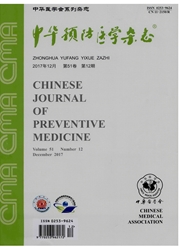

 中文摘要:
中文摘要:
目的探讨乙型肝炎病毒(HBV)前C区1896 G→A点突变对母乳喂养安全性的影响。方法收集62例本院妇产科HBeAg阴性的HBV感染产妇血标本,同时收集这些孕妇产后48h内初乳。应用PCR固相杂交法检测孕妇血清中HBV DNA前C区1896 G→A突变,荧光定量PCR(FQ—PCR)检测孕妇血清和初乳中HBV DNA含量。分析HBV前C区1896 G→A点突变及孕妇血清HBV DNA含量与初乳中HBV DNA含量的对应关系。结果62例孕妇血标本共检测到38例HBV前C区1896G—A点突变(61.3%);突变组初乳HBV DNA阳性率为28.9%(11/38),未突变组初乳HBV DNA阳性率为29.2%(7/24),两组间差异无统计学意义(x^2=0.0003,P〉0.05)。孕妇血中HBV DNA高含量组(≥1×10^5拷贝/ml)初乳HBV DNA阳性率为56.0%(14/25),低含量组(〈1×10^5拷贝/ml)初乳HBV DNA阳性率为10.8%(4/37),两组间差异有统计学意义(x^2=14.79,P〈0.01)。结论HBV前C区1896G—A点突变未对初乳HBV DNA阳性率造成影响,但孕妇血清中HBV DNA含量升高增加了母乳喂养HBV母婴传播的危险性。
 英文摘要:
英文摘要:
Objective To investigate the relationship between pre-core G1896A poiont mutation of hepatitis B virus ( HBV ) and safety of breast feeding. Methods Serum and breast milk samples were collected from 62 pregnant women of HBV DNA positive/HBeAg negative. PCR-solid phase hybridization was used to detect the point mutation in pre-core region G1896A of HBV from pregnant women, and HBV DNA loads in sera and breast milk were determined by fluorescence quantitative PCR (FQ-PCR). Results The prevalence of point mutation was 61.3% ( 38/62 ) in 62 pregnant women with HBsAg positive/HBeAg negative. The positive rate of HBV DNA in breast milk of group with point mutation (28. 9% ) was similar to that of group without mutation (29.2%,x^2 =0. 0003 ,P 〉 0. 05). However,The positive rate of HBV DNA in breast milk of group with high HBV loads (56. 0% ) was significantly higher than that of group with low HBV loads ( 10. 8%, x^2= 14. 79 ,P 〈 0. 01 ). Conclusion The point mutation in pre-core region G1896A of HBV dose not affect the positive rate of HBV DNA in breast milk and higher HBV DNA loads in serum of pregnant women might increase the risk of mother-infant transmission.
 同期刊论文项目
同期刊论文项目
 同项目期刊论文
同项目期刊论文
 期刊信息
期刊信息
